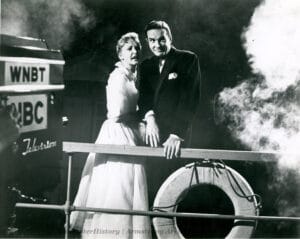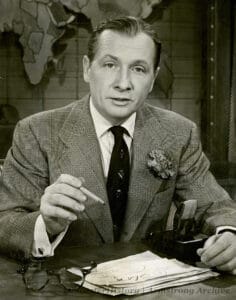This Program Brought To You By | Part 2
This Program Brought To You By:
Armstrong Cork Company & the Golden Age of Television
Written by James McMahon, Ph.D.
Posted by Emily Miller

My name is James McMahon, and for the past several months I have been working as a project archivist for LancasterHistory. My responsibilities include cataloguing and digitizing a vast collection of archival materials that document the significant role of the cork industry in the local economy. This three part series will explore the role radio and television played in advertising and promoting the Armstrong Cork Company (now Armstrong World Industries, Inc.). Part II takes a look at how Armstrong took advantage of the growing popularity of television to launch Armstrong Circle Theatre—a preeminent entry in the era of original television drama developed and sponsored by some of America’s largest and best-known corporations—during a period considered by many to be the Golden Age of Television.

Armstrong entered the world of television programming on Tuesday, June 6, 1950, with the launch of Armstrong Circle Theatre (1950-1963). Throughout its thirteen seasons, the anthology series featured a variety of original docudramas; dramatic presentations of true stories that dealt with contemporary issues, challenges, or events. Taking its cues from the successful Armstrong Theatre of Today radio program, the television show included a host/narrator, commercials promoting various Armstrong products, and many of the established and rising stars of the day. As a corporate anthology series, the program shared many of the same features as other well-known contemporary “television playhouse” programs including Kraft Television Theatre (1947-1958); Philco Television Playhouse (1948-1956); and Texaco Star Theater (1948-1956). Later entries of note in the genre included Ford Theatre (1952-1956); The United States Steel Hour (1953-1963); General Electric Theatre (1953-1962), famously hosted by Ronald Reagan; Kaiser Aluminum Hour (1956-1957); DuPont Show of the Month (1957-1961); and Goodyear Theatre (1957-1960).

Produced by Talent Associates Ltd., Armstrong Circle Theatre debuted as a weekly half-hour program on the NBC television network. For the 1950-1951 season, the series finished in the Nielsen rating at number 19; the only time the program finished in the Nielsen top twenty. The program aired every Tuesday from 9:30pm to 10:00pm from June 1950 until June 1955. Texaco Star Theatre, one of the earliest anthology series programs, finished as the top-rated primetime television series of the season. Beginning with the September 1955 season, Armstrong Circle Theatre expanded to a one-hour format, alternating every four weeks with three other anthology series; the show still airing on Tuesdays, but from 9:30pm to 10:30 pm. Beginning with the 1957 season, the program switched to the CBS television network where it alternated weekly with The United States Steel Hour. On CBS, the program aired on Wednesday evenings from 10:00 to 11:00. The final broadcast of Armstrong Circle Theatre occurred on August 28, 1963.

Nelson Case served as the first host/narrator of the program, typically introducing each episode with the words, “Good evening and welcome to Armstrong’s Circle Theatre.” Actress Kay Campbell served as spokesperson, introducing commercials advertising various Armstrong products targeted to female viewers. Program host/narrators for the half-hour version of the program included Nelson Case (1950-1951); Joe Ripley (1952-1953); Bob Sherry (1953-1954); and Sandy Becker (1954-1955). Case proved to be an ideal choice to get the program off to a successful start. Already a popular radio broadcaster for NBC in New York, Case was also an experienced announcer whose credits included radio programs as well as musical broadcasts headlined by such well-known bandleaders as Wayne King, Ray Noble, Phil Spitalny, and Guy Lombardo.

Believing that the significance of the topics being presented to the viewing public would be enhanced by having a news anchor serve as host/narrator, NBC engaged news anchor John Cameron Swayze to serve as host/narrator for the expanded one-hour format from the fall of 1955 until the series moved to CBS in the fall of 1957. A press release at the time of his hiring touted “Swayze’s keen knowledge of current events, his warm and friendly approach, and above all his sharp sense of what is prominent in the news makes him uniquely suited to the task of interpreting stories that appear on Armstrong Circle Theatre.” When the program moved to CBS in 1957, Swayze was replaced by CBS news anchor Douglas Edwards who served as host/narrator until the fall of 1961 when he was replaced with former ABC news reporter Ron Cochran who was in return replaced with host/narrator Henry Hamilton for the final season.
The docudramas presented by Armstrong Circle Theatre covered topics of contemporary interest ranging from espionage and the history of Soviet-style communism to the advances being made in public health and technology. The program also tackled important and often controversial topics associated with societal challenges such as poverty, alcoholism, gambling, crime, and medical and insurance fraud.
The realistic portrayal of contemporary issues, challenges, and events on Armstrong Circle Theatre earned the company accolades from a variety of community and social service organizations. An article that appeared in the winter 1961 issue of The Armstrong Reporter, a company produced magazine for employees, was typical of those praises:
Award for Circle Theatre
Armstrong has won an “Award of Honor” for outstanding documentary dramas on health and welfare problems presented on Circle Theatre. Given by the Social Work Recruiting Committee of Greater New York, the award was presented by actress Katherine Cornell. Max Banzhaf, Director of Advertising, Promotion and Public Relations, accepted the award for the company.
The Company was cited for its “series of television documentary dramas… which have continually—and at all times at the highest standards of quality—brought entertainment… about the health and welfare problems of our times and the role of community institutions and professionally trained, skilled social workers in resolving these problems.”

Armstrong also received citations from a variety of national organizations, including the American Cancer Society.
By the early 1960s, escalating costs associated with producing a network television show coupled with increasing regulatory oversight by the federal government meant the end of the Golden Age of Television and the era of original television dramas developed and sponsored by companies like Armstrong. When the television networks took over responsibility for programming in 1963, Armstrong refused to abandon television as an advertising medium. During the 1960s, Armstrong instead sponsored several network affiliated television shows, a series of television movies based on adaptations of classic Broadway shows, and a sequence of commercials featuring well-known television personalities to introduce the viewing public to various Armstrong do-it-yourself home improvement projects.
Tune in to our third and final installment when we take a look at some of the programs and personalities of the 1960s that helped to keep Armstrong in the forefront in the minds of consumers.
Stay tuned for Part 3 of “This Program Brought To You By.” Thank you!
From Archives Blog

